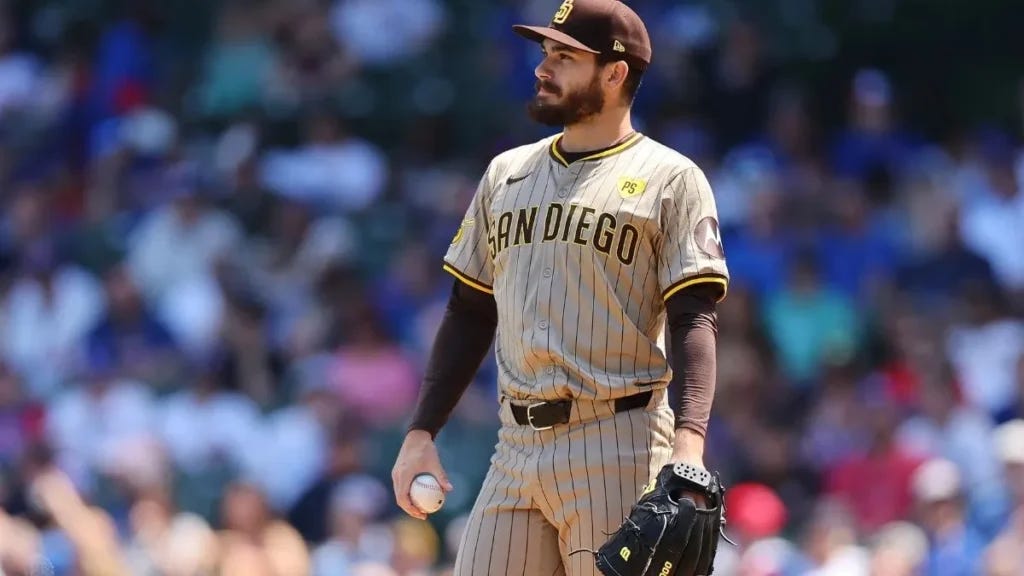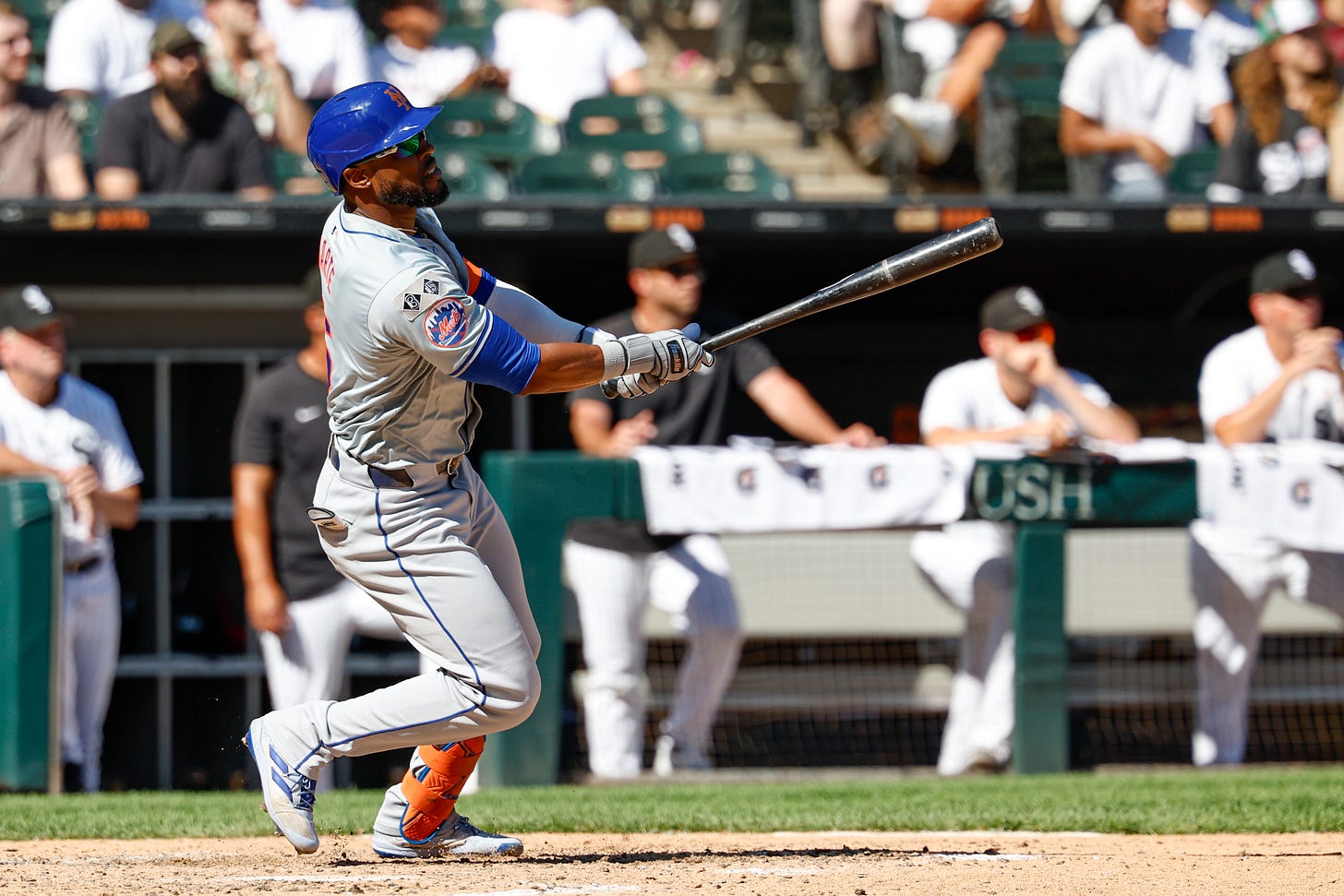There's still one more move for the Mets, but how likely is it?
The only question mark left for the Mets is their starting rotation
What’s up with the Mets? 🍎
The Mets will have a patch on their jerseys in 2025 honoring the late Ed Kranepool, who passed away this winter (Jay Horwitz on Amazin’ Day)
Fans can attend open workouts at Clover Park in Port St. Lucie beginning Wednesday morning, February 12, at 9:30 AM. Entrance to the back fields are free of charge, although fans will be charged $15 to park at the stadium
An A-Grade winter for the Mets still needs one more move… ✍️
On paper, the Mets have a very good team. If I had to grade the front office’s performance this winter, they’d get an A.
When I play my fantasy GM role every winter, I always look at the existing roster with the goal of having a player at each position who can start on every major league team.
The Mets, either via holdovers or through acquisitions/retainments, have players at eight positions who could or would start for every team in some way, shape, or form.
So, mission accomplished in my fantasy GM world.
In reality, nobody can argue that the Mets haven’t had a fantastic winter. They’ve checked most every box on their whiteboard, even if it took on a different shape than they might have anticipated. Juan Soto obviously increased the value of their opening day roster in ways no other free agent could, but his arrival has allowed the Mets to improve on the margins at a bargain that solidifies and protects the Mets newly modified core.
For instance, Jesse Winker, Nick Madrigal, and José Siri are projected to produce 2.1 fWAR (Steamer projection) for - at most - $11.25 million. That’s an average of $5.36 per WAR paid if they hit that projection, and even less if they provide more value in 2025. Given the average amount paid per WAR has been at least $8 million this winter, even in a slow market, the Mets did very well with these three players alone.
On the accounting side of it anyway, that is - in part anyway - what allowed the Mets to go over-market for Pete Alonso in the one guaranteed season he is going to be back with the Mets. It’s not to say the Mets had extra money to spend on Pete. After all, it was Steve Cohen who reminded the public on Amazin’ Day at Citi Field how expensive this roster was without him. But since the Mets found potential value at a fraction of the going rate in the back of their roster, they could afford to assume more risk in an over-market pay to bring back a franchise icon, which has unquantified value to them that didn’t exist with any other club.
All told, the Mets have the fourth highest projected fWAR in baseball, behind only the Yankees, Braves, and Dodgers. Yes, Soto is a big reason for that, but so is Alonso. So are the two major bullpen additions, the quantity in their rotation, as well as their additions on the margins:
The one area of concern, as we all know, is the rotation. As I just said, there’s quantity there - the Mets sought to have 8-10 major league-capable starting pitchers for their six-man rotation in 2025. But aside from Sean Manaea, the rotation has more questions than answers, and that’s putting it nicely.
David Stearns’ strategy here has been to avoid long-term deals with free-agent starting pitchers, most of which are at least 30 years old and older. To be fair, almost none of those deals ever end well, and some of them don’t even start well either. Hell, even the big deal the Dodgers gave Yoshinobu Yamamoto has gotten off to a rocky start from a health perspective, and he is exactly the kind of pitcher the Mets would pursue (as proven by their attempt to sign him last winter).
But that strategy severely handcuffs the Mets’ ability to find reliable starting pitchers who have been healthy and/or productive in the recent past. So, they hope to find motivated reclamation projects at a fraction of the going rate, stick them in their secret pitching lab (which, since we all know about it, isn’t a secret, is it?), and attempt to make them worth more than what they’re paying them.
It worked with Taijuan Walker, Sean Manaea, Luis Severino, and a few others. But this isn’t an exact science here, and it doesn’t work with everyone. Adrian Houser is an example of that.
Now, they will have you believe that there’s no risk in this strategy, or there’s less risk with this strategy than there might be in signing a starting pitcher to a long-term deal. I am one that favors short-term deals for starting pitchers myself, but the Mets are betting on a lot of hope their process works with way too many pitchers who have similar problems than I am comfortable with myself.
Not to mention they really have no idea what to expect from Kodai Senga.
As such, the projected fWAR among their starting pitchers is 11.2, which is the tenth lowest starting pitching projection in MLB heading into the season.
That brings me to the situation in San Diego, where there’s a lot of buzz that the Padres would be willing to move Dylan Cease or Michael King to create payroll space to fill other needs. The Mets have reportedly shown interest in Cease, although it remains unclear what their appetite could be to part with the prospects required to get him.
But, if they can get Cease for a top 6 prospect not named Brandon Sproat and a 10-15 prospect, how can the Mets not entertain such a deal? A rotation of Cease, Senga, Manaea at the front is far more formidable with far fewer question marks than the way it is now, and would create significant separation between them and both the Phillies and the Braves.
Cease also fits Stearns’ criteria - he can be had on a short-term basis at a minimum.
Now, here’s another problem.
Per Spotrac, the Mets projected payroll in 2025 right now is $301.9 million, the highest number in the game. They’re in the 110% tax bracket now, meaning they’re paying more than double on new money they add to the books. Cease will earn $13.5 million in 2025. So, from that perspective, it’s difficult to see the Mets adding new money to the rotation without jettisoning a bigger contract or part of a bigger contract from the roster.
Also, they’d have to move a starting pitcher to create strategic space on the roster.
It also doesn’t seem likely the Padres would consider taking a contract like Starling Marte’s or Jeff McNeil’s back since they’re looking to shed payroll, and not make like-for-like financial moves for their roster.
Also - Marte and McNeil have significant roles on this team right now. That doesn’t mean either aren’t expendable, but the Mets value McNeil’s versatility specifically, and that will come in handy when someone inevitably gets hurt during the season.
So, if I had to wager, the Mets are going to proceed into the season as-is with their rotation and bank on finding six starting pitchers among this group to pitch them into July, at which point Stearns will be able to go back to the market if necessary and find a short-term solution to make this rotation playoff-caliber. Perhaps that is Cease or King, maybe it’s someone like Jack Flaherty if Detroit isn’t contenting, or someone else who we aren’t thinking about in February.
But their questions in the rotation should not diminish the work Stearns and co. have done this winter. They’ve played the markets perfectly, even if they aren’t player/product friendly. They’ve stuck to their guns when they’ve had to with their negotiations and won out in the end by using the baseball calendar to their advantage, and still managed to address most every need on their roster. And by all accounts, they’re selling the Mets as a family-centric organization which has made the club an attractive destination for free agents.
They’ve also managed to protect their growing pipeline of players from the minor leagues in the process. For now, anyway. There will come a time Stearns will have to start making bigger trades and taking some risks by parting with some of their prospects for some significant additions to the rotation.
After all, they can’t hoard prospects forever. Risk is a part of the game.
Around the League 🚩
The Padres are signing veteran OF Jason Heyward to a major league contract as well as OF Connor Joe (Athletic | Star Tribune)
RHP Jeurys Familia is attempting a comeback in MLB (BeisbolFr)
INF Trey Mancini and the Diamondbacks agreed to a minor league deal (ESPN)







I'm with you, but...giving up more than one blue chip prospect for a rental (Cease) would be a mistake. I think sooner or later Stearns needs to come off his stance of refusing long term contracts for pitchers 30 or older. And that's because it's very unusual for a proven star pitcher to come on the free agent market when they're under 30. Which means that the Mets can never sign a top free agent pitcher because in this market they can get 5 year deals. Which leaves them hunting at the margins for turnarounds like Severino last year and Montas this year. Stearns may not like it (neither do I) but you have to adjust to the market. Otherwise, you lose out. David and Uncle Steve: approach the Padres with a sign and trade for Cease. If you can sign him for, say, four years then it'd be worth sending them 2 or maybe 3 top prospects. I'd try to hold on to Jett W. if at all possible.
Great analysis. There are questions for sure, but David Stearns isn't one of them. The man knows his business.
I think you're right, though: we're done for now at $301.9 million. Cohen went the extra mile for Pete, and that's it until the summer unless the Padres come with a sweetheart deal for Cease or King, and Stearns can clear a contract somehow in the process.
Personally, I think I'd rather have King. There's something in Cease's mechanics which really bothers me. I think it's the hard recoil in his left knee as he delivers the ball over the semi-stiff front leg. Every time I see it, something in my head hears "pop."
Don't get me wrong, he has a great upright delivery: balanced, dynamic, decent arm angle, great plant, and the way he extends his glove side and rotates his hips through gives him tremendous power. His stuff is vicious.
I just worry about the strain on his knee.